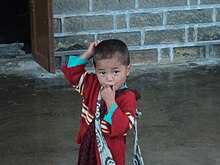Khasi people

A Khasi child
|
|
| Total population | |
|---|---|
| approx. 2,000,000 | |
| Regions with significant populations | |
| Meghalaya (India) | 1,715,000 |
| Assam (India) | 35,000 |
| West Bengal, Mizoram, Maharashtra, Tripura, Tamil Nadu, Arunachal Pradesh, Nicobar Islands (India) | 50,000 |
| Languages | |
| Khasi | |
| Religion | |
| (1.) Christianity (85%), (2.) Ka Niam Khasi (10%), (3.) Hinduism (3%), and (4.) Islam (2%) . | |
| Related ethnic groups | |
| Khmers, Palaungs, Was, Kinh, Nicobarese and other Mon–Khmers | |
The Khasi people are an indigenous tribe, the majority of whom live in the State of Meghalaya which is in the north eastern part of India, with a significant population in the border areas of the neighboring state of Assam, and in certain parts of Bangladesh. The Khasi people are the native people of Meghalaya and forms the majority about 50% of the state population. They call themselves Ki Khun U Hynñiewtrep, which means "The Children of The Seven Huts" in their language. Their language, also called Khasi, is categorized as the northernmost language under the Austroasiatic family stock. The Khasi language was essentially oral until the arrival of Christian missionaries. Particularly significant in this regard was a Welsh evangelist, Thomas Jones, who transcribed the Khasi language into the Roman script. The Khasi people form the majority of the population of the eastern part of Meghalaya, and is the state's largest community. Though the majority of the 85.00% Khasi populace have embraced Christianity, a substantial minority of the Khasi people still follow and practice their age old indigenous religion, which is known as "Ka Niam Khasi" and it is their belief that the rooster (U Syiar Khraw Jutang) is sacrificed as a substitute for man, it being thought that the rooster "bears the sins of men and by its sacrifice, man will obtain redemption" (compare Kapparot). Other religious group practiced among the Khasis include Roman Catholic, Anglican, Unitarian, Presbyterian (largest Christian denomination among the Khasis), and others. A small number of Khasis, as a result of inter-community marriages, are also Muslims. There is also a very small number of Khasi Hindus inhabiting the Jaintia Hills of Meghalaya. The main crops produced by the Khasi people are betel leaf, areca nut, oranges, local rice, vegetables, etc.
...
Wikipedia
